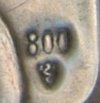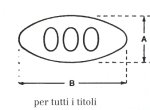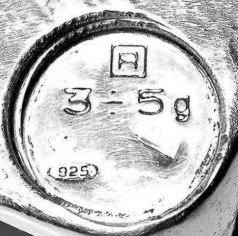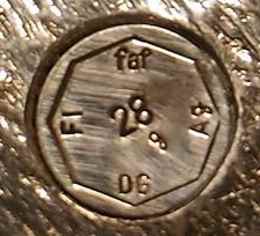HALLMARKS OF ITALIAN SILVER
(LATE 19TH AND 20TH CENTURY)
|
This is a page of A Small
Collection of Antique Silver and Objects of vertu, a 1000
pages richly illustrated website offering all you need to know
about antique silver, sterling silver, silverplate, sheffield
plate, electroplate silver, silverware, flatware, tea services
and tea complements, marks and hallmarks, silver marking system and silver
hallmarks guide, articles, books,
auction catalogs, famous silversmiths (Tiffany, Gorham, Jensen,
Elkington, WMF, Reed & Barton, Mappin & Webb, Bateman Family),
history, oddities ...
SITE MAP -
HOME PAGE
|
| THE DIRECTORY OF 20th CENTURY ITALIAN SILVERSMITHS (SORTED BY PROVINCE) |
This is a brief history and a selection of Italian silver hallmarks from 1870 to present
days.
The documentation about this period of Italian silversmithing is extremely scarce and defficult to find.
The objective of this page is to offer an introduction to this matter and a cue for a more deep study of
this fascinating period.
In 1870, with the conquest of Rome and the end of Stato Pontificio (Papal State), Italy attained its unity
and a unique system of hallmarking was introduced in the Regno d'Italia (Kingdom of Italy).
The law 2 May 1872 deregulated silver production and introduced only a not compulsory inspection of
silver artifacts.
OFFICIAL MARKS (legge 2 Maggio 1872)
1 |
|
optional hallmark, purity degree 950/1000
|
2 |
|
optional hallmark, purity degree 900/1000 |
3 |
|
optional hallmark, purity degree 800/1000 |
Italian silversmiths rarely submitted their pieces to the optional official hallmarking.
Usually silver pieces were marked only with the '800' (purity degree 800/1000), sometimes coupled with
the silversmith's hallmark.
The '800' was an unofficial mark and there was no uniformity in its shape.
4 |
|
'800' with oval outline and VM (presumably silversmith's initials) |
5 |
|
'800' without outline |
6 |
|
'800' without outline coupled to silversmith's mark |
7 |
|
'800' without outline |
The law 5 February 1934 n. 305 introduced uniformity in the shape of silversmith's marks.
The new mark identifying the silversmith consisted of a lozenge containing:
number: corresponding to the number identifying the silversmith
'fascio': fascist party symbol
two letters: initials of the Province
The lozenge was coupled to an oval containing the purity degree 800 or 925 per thousand.
OFFICIAL MARKS (legge 5 Febbraio 1934 n. 305)
8 |
|
'800' and lozenge mark identifying the silversmith
number / fascio / province |
9 |
|
lozenge with 'fascio' |
10 |
|
purity degree '800 into an oval outline |
|
|
special mark for items in stock, used within one year from the acquisition of the new punches. Two versions of the punch were used, similar but of different size, for large works and small works (courtesy Andrea Menarini) |
|
|
BEWARE: pseudo-hallmarks like ARG 800, ARG 1000 and similar don't refer to silver but to SILVERPLATE |
The Law 26 October 1944 n. 313 (Decreto Legislativo Luogotenenziale 26 Ottobre 1944 n. 313) ordered the
elimination of the 'fascio' (symbol of 'fascism') maintaining into the lozenge only the number
(identification of the silversmith) and the two letters (initials of the Province).
The availability of new lozenges was not immediate and for a short period the old marks with the obliterated
'fascio' were maintained.
OFFICIAL MARK (Decreto Legislativo 26 Ottobre 1944 n. 313)
11 |
|
lozenge mark without 'fascio' number/province |
The Laws 30 January 1968 (Legge 30 gennaio 1968 n. 46) and 30 December 1970 n. 1496 (D.P.R. 30
Dicembre 1970 n. 1496) introduced new hallmarks for silver and precious metals. The mark was modified to a polygonal shape
and a star was added on the left. Numbers and Province letter were maintained.
Purity degree 925, 835 and 800 per thousand were allowed and inscribed into an oval outlined mark. Silver fineness 835/1000 is very rarely used.
This system is still in use in present days.
OFFICIAL MARKS (Legge 30 Gennaio 1968 n. 46 and D.P.R. 30 Dicembre 1970 n. 1496 )
12 |
|
polygon with 'star'
star / number / province |
13 |
|
purity degree into an oval outline
'800'
'925'
|
The 'Decreto Legislativo 22 Maggio 1999, n. 251' introduced a system of marks for objects made in precious
metals and weighted with resin or mastic. The new mark is a R inside a square outline (the R is the
abbreviation of 'Riempito' = filled in English).
14 |
|
This piece was created in a resin or
mastic then covered with 3 to 5 grams of 925 standard silver as shown by 3 ÷ 5 |
a) negli oggetti
parzialmente o totalmente rivestiti in lamina di metallo prezioso,
e' consentito l'uso di mastice per fissare la lamina al suo
supporto, a condizione che la densita' del mastice non sia superiore
a 2,5 g/cm 3 e che la sua percentuale in peso non superi il 25% del
peso totale dell'oggetto, e che sia incisa l'indicazione "R"
racchiusa in un quadrato, accompagnata dalla indicazione del peso
del metallo, in grammi e decimi di grammo, seguita dal simbolo "g"
per i rivestimenti in platino, palladio ed oro, e alle condizioni di
cui alla successiva lettera c) per i rivestimenti in argento;
|
a) In the objects partially or totally
coated with a sheet of precious metal, the use of
putty is allowed to fix the thin sheet to its support, on condition that the
density of the putty is not more than 2,5 g/cubic cm. and that its
percentage in weight does not exceed 25% of the total weight of the
object, and that it is marked with an "R" in a square accompanied by the metal's weight
in grams and tenths of gram, followed by the symbol "g" for the
coverings in platinum, palladio and gold, and adheres to the conditions
illustrated at letter c) for the coverings in silver;
|
b) nei piedi o
basamenti di vasi, candelabri, coppe ed oggetti affini, che per
praticita' di uso sono rinforzati ed appesantiti, e' ammessa la
introduzione di un riempimento metallico, a condizione che questo
sia applicato in maniera da poter essere smontato e che risulti
totalmente visibile o che, se ricoperto con piastre o coperchi
metallici o non metallici, tale copertura sia fissata in modo da
poter essere, anche essa, agevolmente smontata. Su ogni parte di
metallo comune, ivi comprese le piastre di copertura, deve essere
impressa l'indicazione "metallo" ovvero il nome specifico del
metallo o della lega impiegati. Nel caso in cui la piastra di
copertura sia in metallo prezioso, essa reca il marchio di
identificazione, l'indicazione del titolo, il termine "riempito",
nonche' il peso del metallo fino espresso in grammi seguito dalla
lettera "g" della piastra stessa; |
b) In the feet or bases of pots,
candelabra, cups and similar objects weighted or strengthened, is
admitted the use of a metallic filling up, to condition that this is
applied in manner to be able to be dismantled and fully visible or,
if covered with metallic or non metallic lids, such covering is
fixed so as to be easily dismantled. Every part of non precious
metal, included the covering lids, will be marked with the generic
indication "metal" or the specific name of the metal or of the
league used. When the covering is in precious metal it is marked
with its specific mark, the title, the word riempito (filled) and
its weight in grams followed from the letter "g";
|
c) nei manici dei
coltelli e' ammesso il riempimento con sostanze non metalliche senza
pregiudizio dei limiti di densita', ed e' consentito altresi' che la
lama sia fissata al manico con saldatura in metallo non prezioso a
condizione che in ogni manico sia inciso il termine "riempito" o
facoltativamente l'indicazione "R" racchiusa in un quadrato,
accompagnata dalla indicazione del peso della lega di metallo
prezioso, in grammi e decimi di grammo, seguita dal simbolo "g". Nei
manici in argento, nei quali il peso del metallo prezioso e'
inferiore o uguale a 50 grammi, detto peso pero' puo' essere
espresso anziche' col suo valore effettivo, in maniera approssimata,
facendo seguire la lettera "R" (riempito) da una delle seguenti
notazioni: due cifre, separate dal simbolo "÷" seguite dalla lettera
"g", nelle quali le cifre rappresentano, in grammi, i valori minimo
e massimo entro i quali il peso stesso deve intendersi contenuto:
1÷2, 2÷3, 3÷5, 5÷7, 7÷10, 10÷13, 13÷16, 16÷20, 20÷25, 25÷30, 30÷35,
35÷40, 40÷45, 45÷50.
|
c) In the handles
of the knives non metallic substance is allowed without limits of its density,
and is allowed to fix the blade with
welding in non-precious metal on condition that the handle bears the
word "riempito" or the mark "R" within a square and the indication of
the weight of the precious metal (in grams and tenths of gram)
followed by the symbol "g". In the silver handles with a weight of
precious metal inferior or equal to 50 grams the weight may be
expressed in approximate manner, using the "R" followed by two
figures, separated from the symbol "÷" and the letter "g", in which
the figures represent, in grams, the minimum and maximum weight of
the precious metal: 1÷2, 2÷3, 3÷5, 5÷7, 7÷10, 10÷13, 13÷16, 16÷20,
20÷25, 25÷30, 30÷35, 35÷40, 40÷45, 45÷50.
|
The 'Decreto Legislativo 22 Maggio 1999, n. 251' introduced a special factory mark for objects made of non-metallic objects covered by precious metals through electroplating process. The new mark is an octagon bearing maker's trade mark, DG (deposizione galvanica - galvanoplasty process), precious metal symbol (Au: gold - Pt: platinum - Pd: palladium - Ag: silver), weight of precious metal in grams and province code.
15 |
|
This is a special factory mark on a non-metallic object covered with 28 grams of silver trough galvanoplasty process. The maker is "faf" (FABBRICA ARGENTERIA FIORENTINA di BARTOLINI BARTOLOZZI & C. S.A.S. owner of mark "215 FI") |
SPECIAL MAKER'S MARK FOR OBJECTS OBTAINED BY GALVANOPLASTY PROCESS
DL 22.5.1999, art. 36, Allegato IX
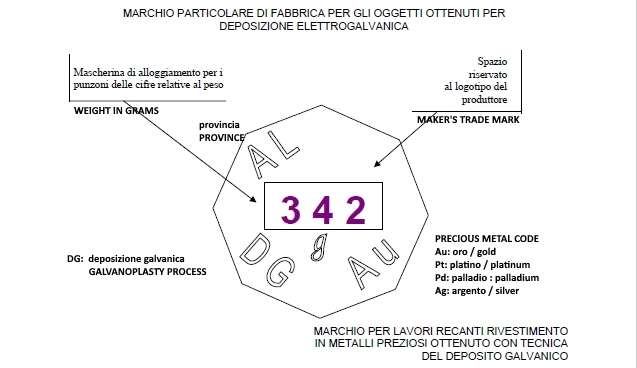
|
HALLMARKING CONVENTION
Italy is country member from 2023 of the Convention on the Control and Marking of Articles of Precious Metals, an international treaty between States on the cross border trade in precious metal articles. It was signed in Vienna in November 1972 and entered into force in 1975.
The Convention's Common Control Mark (CCM) has the same legal status as a national Assay Office mark. The CCM is applied by national Assay Offices to articles of platinum, gold, palladium and silver after the fineness of the alloy has been checked in accordance with agreed testing methods.
Articles bearing the CCM - together with the national Assay Office Mark, the responsibility mark (manufacturer or sponsor) and the fineness mark indicating its purity - do not have to be re-controlled or re-marked in the states members of the Convention.
|

|
THE HALLMARKS SECTION
This is a page of A Small Collection of Antique
Silver and Objects of vertu, a 1000 pages richly
illustrated website offering all you need to know about
antique silver, sterling silver, silverplate, sheffield
plate, electroplate silver, silverware, flatware, tea
services and tea complements, marks and hallmarks,
articles, books, auction catalogs, famous silversmiths
(Tiffany, Gorham, Jensen, Elkington, WMF, Reed & Barton,
Mappin & Webb, Bateman Family), history, oddities ...
SITE MAP
SILVER DICTIONARY
|

www.silvercollection.it
This page was useful? leave your LIKE on
facebook
|
work in progress on this page - your help, corrections and suggestions will be greatly appreciated -
| |
|









